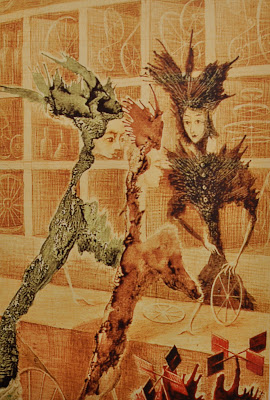I finally got my hands on a copy of the gorgeous book “The Five Keys to the Secret World of Remedios Varo.”
One of the things I have always liked about Remedios Varo’s work is the mysterious yet cohesive narrative present in her images. The Surrealist Movement was full of heady ideas and the study of dreams and alchemical traditions and psychology, but in general, its artists rather strictly adhered to a tradition of uncensored, automatic work: they painted dreams and bizarre pairings but made no effort to pull them together into some semblance of order. While Varo utilized many surrealist techniques, such as decalcomania, and firmly embedded her images in dreamy and surreal atmospheres, the paintings she presented in the last, explosively productive years of her life show a definite narrative purpose. In her essay In Search of the Miraculous, Tere Arcq meticulously outlines the connection Varo had made with the Russian mystic Gurdjieff’s group. She asks,
“What spurred her to distance herself from the automatist experimentation evident in her early works? One possible reason may lie in how Gurdjieff conceived of art. The Russian suggested that there were two kinds of art: objective and subjective. In objective art, the artist creates, but not so in subjective art: ‘With him ‘it is created’[…]this is where the whole difference lies.’ And this difference also lies at the heart of Gurdjieffian thought: man is a machine unable to do anything, to have control over his life and his fate—things simply happen to him. Only when he begins to do work on himself can man cease to be a machine and attain awareness. The subjective artist is a man-machine—an automaton that is incapable of doing anything…”
Towards the Happiness of Women
In the image above, the women are almost completely machine. They move about on wheels instead of feet, which in her own visual vocabulary would make them almost primates:
IMAGE: “Homo Rodans,” Varo’s “archeological discovery” built from the bones of fish and poultry, for which she produce an accompanying study in stuffy academic language.
Tiny wings direct their movement. Their source of happiness is the shop where they can receive updated parts:
Towards the Happiness of Women, detail from book
NOTE: images marked "from the book" can be seen at a much bigger size.
Arcq says, “To Gurdjieff, the automaton is an inferior being, a potential being that requires intense inner work to achieve a state of higher consciousness. Remedios Varo moved away from automatism because she was no longer an automaton…”
Where her Surrealist counterparts were focusing on the nightmarish visions that the events of the wars around them and the behaviors of the people involved might easily provoke, Varo was moving towards something else. Though she, too, suffered the dangers and upheavals of war—the Spanish Revolution and the armies of Hitler—she seemed to be approaching something better rather than running away. She arrived at her last home, in Mexico, and put her mind to study and creation, joining groups founded by the Russian mystics Gurdjieff and Ouspensky, analyzing her dreams and concocting recipes to control them with her friend Carrington, and painting.
Again from Arcq: “The Russian mystic P.D. Ouspensky stated that art is a means of knowledge and that by devoting himself to creation, the artist opens his mind to a multiplicity of possibilities, and is able to reveal enigmas and lead humankind toward the sphere of the unknown…so that his work might become the vehicle for the revelation of a higher reality.”
This is the purpose, to me, of art—of all creativity: not to mirror our worst side, to show us the beasts within and the darkness we are capable of—all of that is clear as day, in front of us, and is already presented to us on the television anyway. The purpose is to create a door in the wall, or at least a clerestory, some way for those of us in the gutter, as Wilde so famously said, to gaze upon the stars.
We contain the entire universe, all of its multiple versions, within us,
Center of the Universe
and to choose to enact the weakest, basest narrative is mindless, incomprehensible.
In the painting below, “The Red Weaver,” the eponymous weaver is fading into shadow, melting into the wall. In the background, two old skins hang from the ceiling and one from the wall. The red blood of life pulses through the weave of her creation as it lifts itself towards the window and out of the cramped room to sail through the sky.
Oppose this with the messy machinations of the puppets of astrological forces here:
Sympathy, from the web
or the repetitive, plodding (mechanical) movements those forces compel here:
In her essay, "Dreams of Alchemy," Fariba Bogzaran brings all of this together, saying :
"Although Remedios Varo was not interested in illustrating her dreams as some Surrealists did, many of her paintings suggest a complex 'dream-like' but conscious narrative with a wide range of possibilities, as is often experienced in lucid dreams where the dreamer gains awareness that he or she is dreaming and becomes a co-creator with the unconscious world (162)."
Therein lies the distinction: she is not an automaton, calling upon the knowledge of the subconscious and then doing no more than recording its suggestions. She has woken inside the dream, realized it is *a* dream, and reached out with her fingers to nudge certain details into place, to improve it. When Engel talks of her paintings, he also compares them to dreams: "In her best paintings, each of these locales convinces us that it is the one and only center of the universe, just as a compelling dream must depict not merely a reality but reality itself."
Embroidering the Earth's Mantel, from the book
cropped to avoid book crease
First, by her meticulous attention to detail, and through the use of surrealist techniques such as decalcomania, which allow for textures unattainable with a brush, she creates a world outside the normal realm of possibility, and makes it real, makes it convincing.
IMAGE: (the clouds of the sky are created using a technique called decalcomania, which involves pressing the paint between two sheets of paper and pressing the resulting pattern onto the canvas.)
IMAGE: (the tiny world looks just like ours, only now we see it from a "fourth" dimension, with its creators present. The curvature of the earth and the folds of mountains makes sense in this view)
Then, she subverts that "reality," with even further detail:
Detail from Embroidering the Earth's Mantel, from the book
The creators, Catholic school-girls trapped in a tower under the watchful and all-powerful gaze of the matron, endlessly weave a world they are never able to partake in. All the beautiful water! The oceans, the mountains! Secretly, the girl to the left has found a way out: if she is truly making this world, then how could she not? She creates a lover, and she plots their escape. Any minute now, they will solidify, and, reaching the earth below, be free. When we look at the world around us, every detail seems so firm, so real, and so the reality we believe we are seeing seems objective, permanent, unchangeable. But the same is true in a dream, until we wake from it. With this small detail, Varo shows us, that through a creative act (no matter how tiny), we can alter reality in massive ways; this idea is one of the main building blocks of all her work.
PART TWO
Another Gurdjieffan theme that finds life in Varo's paintings is again an idea purported by the new physics, and one that also fits in neatly with the idea of the entire world as a dream (one from which we don't particularly want to wake up, but in which we want to become aware): that is the idea that everything is alive. In the 1950s, a painter named Christopher Fremantle led lessons in Gurdjieff's teaching in Varo's neighborhood in Mexico. One experiment he liked them to practice weekly involved both professional artists and amateurs to take up their drawing pencils and paints and create. In an interview with Lillian Firestone, one of the group's members, Arcq learned about these sessions: "The study focused on observation: they would observe an object for a lengthy period, and then capture the impressions that the object in question had caused in them. 'No inanimate object was seen to be completely devoid of movement[...] We saw the 'livingness' even of rocks[...] Even a perfectly round orange was revealed as a complex kingdom of curves and whorls.'"

Visit to the Past (from book)
There are several things to think about in the above image. There is the life present in things, for example, that we see peeling itself out of the table, the chair-back, the walls, the sprouting carpet, and the dancing chair. The first thing the face emerging from the table makes me think of is the idea that the atoms that make up my body are constantly interchanging with those of everything around me, for example the table I am sitting. And if I sit at that table for 10-12 hours every day for 40 years, how much of that table has memories from my own existence inside it? Could anyone ever see those memories? Could anyone ever interact with them? Could they influence the behavior of the next person sitting at that desk? Could that person learn from my mistakes and gain strength from my strengths?
Recently, I ran across the word "spectrality," in an essay about De Chirico, Magritte, Balthus and Ernst from the catalogue of the 2010 show at the Palazzo Strozzi involving the works of all four. In talking about De Chirico and Ernst, the author writes, "In Ernst's view, the painter's job is to record what he 'sees' with his mind's eye, allowing his own will to interfere as little as possible. He inherited De Chirico's belief in the independent life of matter, taking the concept of 'spectrality'--in which concrete elements take on unexpected meanings--to new heights through his use of collage... The trends in European painting between World War I and the 1930s that opted for a realism capable of hinting at a 'second life' in things that transcended their purely visible aspect, were undeniably influenced by De Chirico's metaphysical art."
A concrete element-- for example, the table in "Visit to the Past," now takes on another meaning: that of the past. The table is not merely furniture; it is the carrier of memories, it is part of a room that has had life in it before the entrance of this new woman, it was once a central part of someone else's life in that room. Beyond that, it was once a collection of chunks of wood that a carpenter smoothed into planks, sealed against damage. and fixed into its present shape. It contains the love of that carpenter's hands, love that developed out of a life to lead those hands to work with wood. Before that, it was a tree, or several trees, and it lived in a forest, *it lived* amongst other trees and birds and animals, and if you lay your head on that table, ear down, you can hear the stream trickling over rocks in the distance. In this painting, all those things, all the lives that were ever connected in some way with that table, are here now. Around the legs of the table, grass and flowers grow again. A breeze blows, and a branch in the shape of a chair bobs and tilts.
That is the Surrealist definition of 'spectrality,' but in our everyday world, yourdictionary.com offers another--it is the noun form of the adjective 'spectral,': of, having the nature of, or like a specter; phantom; ghostly. This definition merges two of the ideas in this drawing: the ghost of the past and the thin, illusory (phantom) sheen of image that "reality" really is.
Harmony (from web)
Detail of Harmony (from book)
Engel describes the above painting: “In this complex and moving work, the forces of order (mathematical formulas, perfect geometric solids, the logic of musical theory) find themselves fiercely at odds with the chaotic disintegration of the room itself: the floor tiles buckle up from sprouting weeds, a bird has constructed a nest in the fabric of a chair, the scientist’s drawers and trunk are overflowing with debris, and, of course, the walls themselves are decomposing.” This conflict is there because, as we look around us, we are placing an order woven simply by faith and perspective as only a thin layer, a holograph, over the chaos of teeming atoms—parallel realities, endless possibilities. Your atoms, which are constantly interchanging with the atoms of the desk in front of you, the keyboard, the doorknobs, the grain of the wood flooring, the carpet fibers; there is no real distinction. There is no real reason you couldn't part the walls and pass through to the other side.
There is much, much more in this book. And the paintings are large, clear, and in beautiful color, with details pulled out and magnified. There are sketches, and images of hand-written dream-creating recipes, and the examples of her work range from her beginning Surrealist works in Europe to the unique style she created once she'd settled in Mexico. There are essays focusing on the architecture in her work, on the effect of dreams on her work, on the impact of all the time in cafes working on exquisite corpses, and on the beliefs of Gurdjieff's students and their expression in her work. It is gorgeous, a must-have.
 The title is a portmanteau, which he unpacks: “The artist and sphinx are combined in a form that suggests a question mark and therefore a riddle. The artist’s hands are brushes, suggesting that he has drawn himself into existence in an effort to find meaning and truth.”
The title is a portmanteau, which he unpacks: “The artist and sphinx are combined in a form that suggests a question mark and therefore a riddle. The artist’s hands are brushes, suggesting that he has drawn himself into existence in an effort to find meaning and truth.”





















